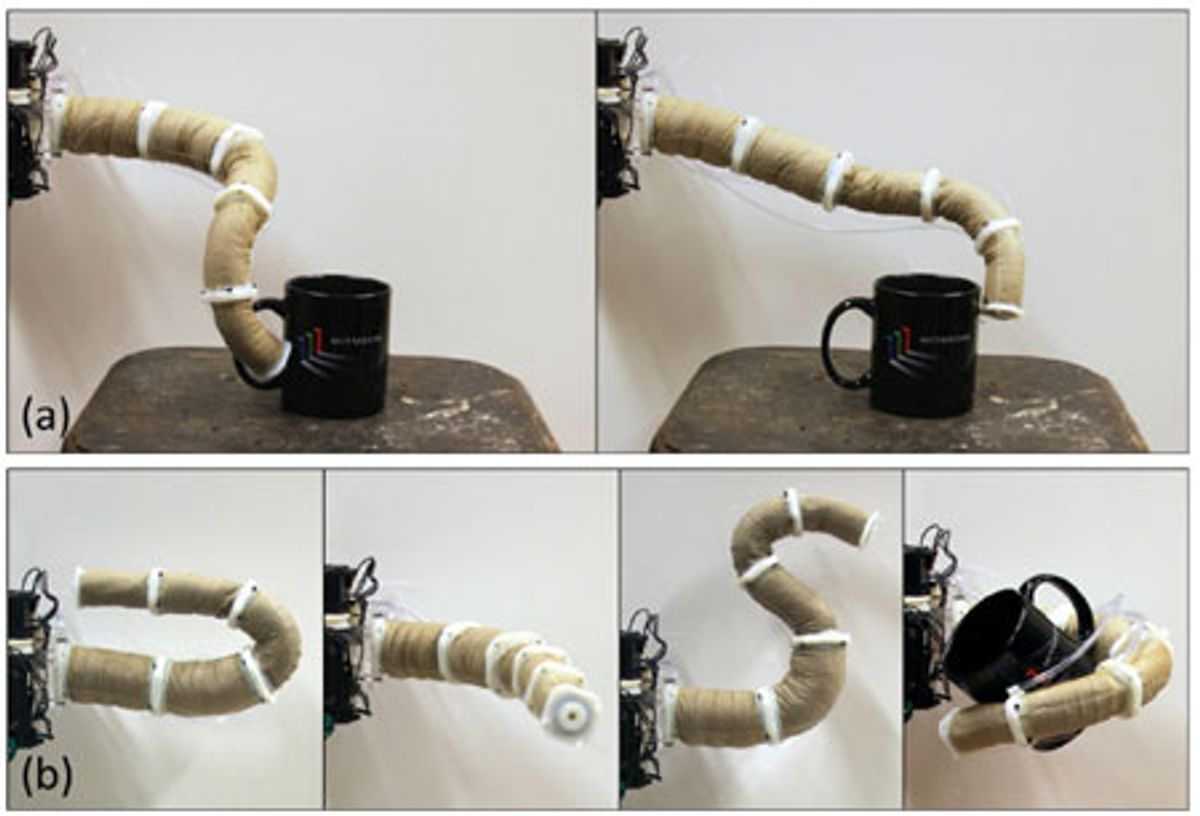“Jamming” has to be one of the coolest new actuation techniques we’ve seen in the last couple years, and we’ve recently covered a bunch of fascinating implementations of it, including walking robots and grippers that can throw stuff. MIT may have just topped everyone by developing a robotic elephant trunk that’s strong, flexible, and, since it’s made mostly out of coffee grounds, absolutely dirt cheap.
The jamming technique was developed jointly at Cornell University, University of Chicago, and iRobot back in late 2010. For a detailed discussion of how the gripper works, check out our 2010 interview with Eric Brown, lead author on the original paper describing jamming grippers, but if you’re in a hurry, the nutshell is that you can take a balloon and fill it with coffee grounds, and you’ll have a squishy blob. Great! Now, if you pump all of the air out of the balloon, the coffee grounds “jam” together into a solid mass, and your squishy blob all of a sudden turns rigid, firmly gripping anything it had blobbed around. The key point is this: by adding or removing air, a jamming system can go from flexible to rigid and back again.
A group of researchers from MIT took this concept and applied to a robotic arm that looks an awful lot like an elephant’s trunk, and that has similar movement capabilities as well. The arm is made up of a bunch of different jamming segments stuck together at the ends, with separate vacuum valves to each segment and a set of four control cables spaced at 90 degree intervals around the outside of the entire thing. As the control cables pull on the arm, the segments smoothly flex, but by jamming selected segments and turning them rigid (an operation that takes just 0.2 second), you can alter the motion of the arm in complex ways, allowing trunk-like gripping motions. Here’s the rather curious looking video:
What’s great about this gripping system (besides the look, of course) is that it’s very cheap and very robust, while being simultaneously as rigid and as flexible as you like, since you can add lots more segments without increasing the overall complexity of the system all that much. The “cheap” part will likely be the most appealing to most researchers and hobbyists: all you need to make this thing (more or less) are thin flexible membranes (like balloons), cables, drive motors, a vacuum source and tubing, and (most importantly) some coarse-ground coffee. Oh yes, they checked, coarse ground is more effective than fine ground, so all of you espresso snobs are out of luck.
Next up for the trunkbot is a bunch of tweaking to try to find the ideal filler material (both grain size and composition being important), followed by the addition of some sort of manipulator, which really should be something like this just to keep the intermittently squishy theme going. Next comes embedded sensing, control, path planning, and all that kind of stuff, followed by a potential career in underwater robotics, where the external pressure exerted by the sea water makes the jamming pressure far higher than you’d ever find here on land.
Design and Analysis of a Robust, Low-cost, Highly Articulated Manipulator Enabled by Jamming of Granular Media was presented by Nadia G. Cheng, Maxim B. Lobovsky, Steven J. Keating, Adam M. Setapen, Katy I. Gero, Anette E. Hosoi, and Karl D. Iagnemma from the Massachusetts Institute of Technology, on Thursday at the 2012 IEEE International Conference on Robotics and Automation in St. Paul, Minn.
Evan Ackerman is a senior editor at IEEE Spectrum. Since 2007, he has written over 6,000 articles on robotics and technology. He has a degree in Martian geology and is excellent at playing bagpipes.




